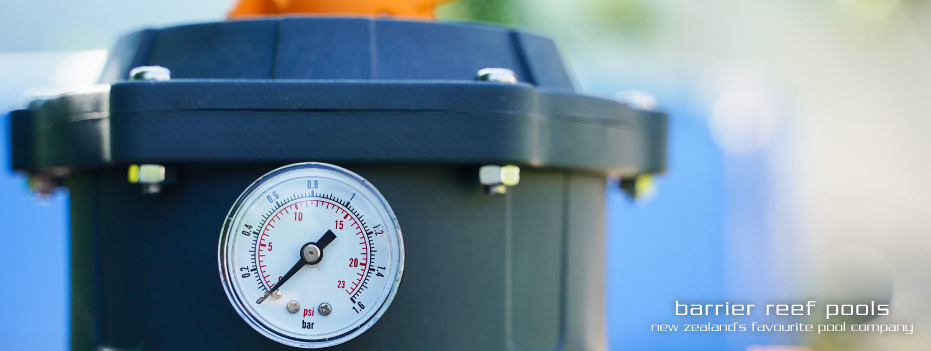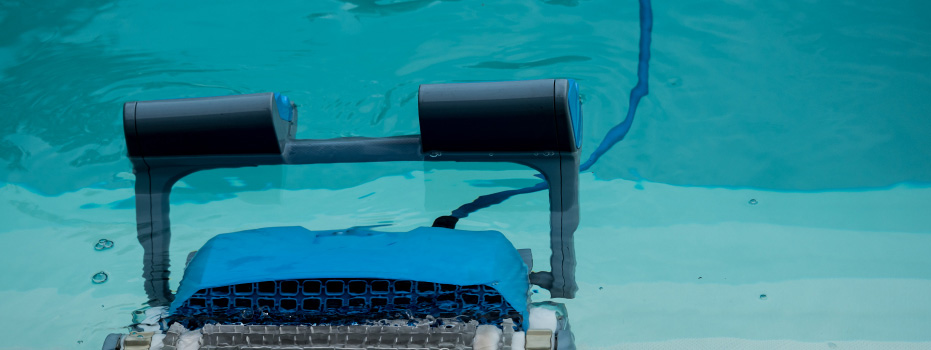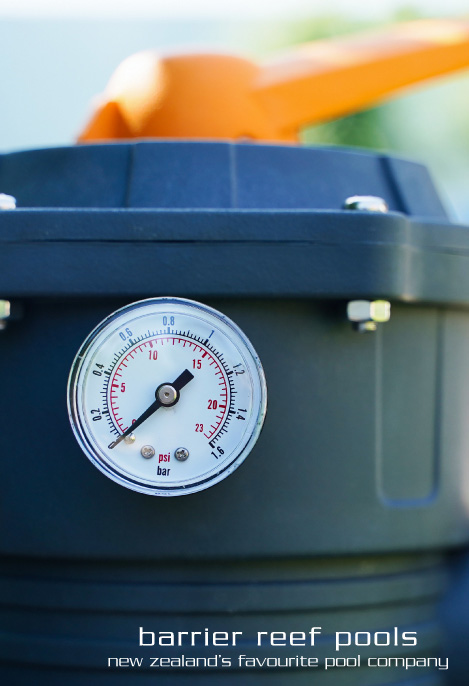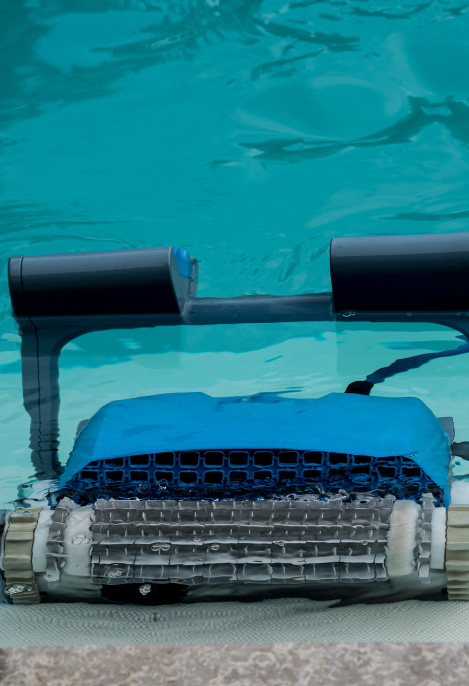Why You Should Always Keep An Eye On The Pool Filter Pressure Gauge
The pressure gauge of the pool filter of your fibreglass pool is a relatively inexpensive piece of equipment. However, despite its price, it plays the role of a pool technician as well. In order to communicate with this pool technician, however, you'll have to rely on numbers. The pressure gauge is also not good at helping you with manual labour, but it can let you know important information about your pool.

Should anything be wrong with your fibreglass pool, the first indication that you'll get is through the pool filter gauge. But what exactly is a pool filter pressure gauge?
Pool Pressure Gauge: What Is It?
The pressure gauge lets you know what the PSI of the pool filter is. The pool filter requires pressure within the tank, in order to function. Any time the filter pressure appears normal, this means that water is moving through in a seamless manner. It also means that your other pool equipment is also operating efficiently.
If this pressure ends up rising too much or falling too low, then this can affect how the water flows through the system. When this happens, the circulation system of your fibreglass pool won’t be working well. If repairs and replacements are needed, then they can be expensive.
Essentially, the pool pressure gauge is the small dial that you can find on top of the pool filter. It looks very similar to what thermometers used to look like before. It also looks similar to cooking thermometers, like the kind used to test the internal temperature of turkeys and steaks. When you check this small dial, you’ll be able to monitor the pressure in the filter.
What Kind Of Operating Pressure Is Normal?
There are a few factors that go into determining what operating pressure is ideal for your pool. These include the size of your pool pump, the horsepower of that pump, as well as the size of your pool filter. It also depends on how clean your pool filter currently is.
Although the operating pressure that’s normal for your fibreglass pool is unique, you can still find out what it is. What you’ll need to do is check what the operating pressure is when the filter media is first installed.
When you turn the pool pump on, the number you see on the gauge is what the baseline pressure is. You’ll also need to write the PSI number down after you clean the pool filter for the first time. For DE and sand filters, this is when you first backwash your pool filter. Note these two numbers down carefully, as they’ll let you know what your ideal operating range is.

What Happens When The PSI Is Too High?
Say you notice that the PSI is above what should be your normal pressure for operating. It’s often good to have the pressure be slightly high. This is because it indicates that any foreign contaminants caught by your pool filter are helping to trap more contaminants. But how do you know that the PSI is too high?
When you see that the pressure gauge is 10 PSI above the ideal range, it’s time for you to intervene. At this time, you should clean the pool filter, a vital part of a pool operating system. If you have a cartridge filter, then you’ll need to hose it down. Sand and DE filters will need to be backwashed. When backwashing your pool filter, ensure that it’s being backwashed to the right area. You don’t want to end up getting fined by the local government for environmental contamination.
If you’ve cleaned your pool filter, but this didn’t lower your PSI, it’s time for a replacement. If you didn’t know what the normal range for operating was before, you can use this opportunity to find out.
What If The PSI Is Still High?
There’s a relief valve for air in the pool pressure gauge, which is responsible for keeping the level of the pressure in check. Should the PSI be high even after replacing the filter media, the issue could be a relief valve for air. If air has gotten into your filter, then this is a problem. You’ll need to check the water level of your pool.
If the water level isn’t halfway submerging the skimmer, then this could be where the air is entering from. To fix this issue, open your air relief valve while running the pool filter. You should allow the filter to run until you notice water leaking from the valve. Consider priming your pump as well, as there could be air in other parts of your pool system as well.

What Happens When The PSI Is Too Low?
If the PSI number on the pool pressure gauge is too low, then this means that the water is not flowing how it should. If you see that the PSI figure is 5 PSI under what it should be, then you’ll need to do some unclogging. This is because it’s likely that there is some kind of blockage.
This blockage could be located near the filter. You’ll need to inspect the pool skimmers as well as the drain covers. Your pump basket as well as pump impeller will also need to be checked. You might find dirt, leaves, twigs, and other foreign contaminants, causing a blockage.
If this doesn’t solve the problem, then you’re most likely dealing with a leak. Should this be the case, then you’ll most likely need to hire a pool professional to get the issue resolved.
Conclusion
Sometimes, it could be the pressure gauge itself that’s the problem. Turn your pool pump off, and then check the reading on the pressure gauge. It should show a zero. If this isn’t the case, then the gauge could be the issue. A pool professional should be able to help you deal with the issue.
Keeping an eye on the pool pressure gauge is important, as you can monitor how well your pool system is performing. Use this guide to learn what a pool pressure gauge is, as well as why you should monitor it.
Why You Should Always Keep An Eye On The Pool Filter Pressure Gauge
The pressure gauge of the pool filter of your fibreglass pool is a relatively inexpensive piece of equipment. However, despite its price, it plays the role of a pool technician as well. In order to communicate with this pool technician, however, you'll have to rely on numbers. The pressure gauge is also not good at helping you with manual labour, but it can let you know important information about your pool.

Should anything be wrong with your fibreglass pool, the first indication that you'll get is through the pool filter gauge. But what exactly is a pool filter pressure gauge?
Pool Pressure Gauge: What Is It?
The pressure gauge lets you know what the PSI of the pool filter is. The pool filter requires pressure within the tank, in order to function. Any time the filter pressure appears normal, this means that water is moving through in a seamless manner. It also means that your other pool equipment is also operating efficiently.
If this pressure ends up rising too much or falling too low, then this can affect how the water flows through the system. When this happens, the circulation system of your fibreglass pool won’t be working well. If repairs and replacements are needed, then they can be expensive.
Essentially, the pool pressure gauge is the small dial that you can find on top of the pool filter. It looks very similar to what thermometers used to look like before. It also looks similar to cooking thermometers, like the kind used to test the internal temperature of turkeys and steaks. When you check this small dial, you’ll be able to monitor the pressure in the filter.
What Kind Of Operating Pressure Is Normal?
There are a few factors that go into determining what operating pressure is ideal for your pool. These include the size of your pool pump, the horsepower of that pump, as well as the size of your pool filter. It also depends on how clean your pool filter currently is.
Although the operating pressure that’s normal for your fibreglass pool is unique, you can still find out what it is. What you’ll need to do is check what the operating pressure is when the filter media is first installed.
When you turn the pool pump on, the number you see on the gauge is what the baseline pressure is. You’ll also need to write the PSI number down after you clean the pool filter for the first time. For DE and sand filters, this is when you first backwash your pool filter. Note these two numbers down carefully, as they’ll let you know what your ideal operating range is.

What Happens When The PSI Is Too High?
Say you notice that the PSI is above what should be your normal pressure for operating. It’s often good to have the pressure be slightly high. This is because it indicates that any foreign contaminants caught by your pool filter are helping to trap more contaminants. But how do you know that the PSI is too high?
When you see that the pressure gauge is 10 PSI above the ideal range, it’s time for you to intervene. At this time, you should clean the pool filter, a vital part of a pool operating system. If you have a cartridge filter, then you’ll need to hose it down. Sand and DE filters will need to be backwashed. When backwashing your pool filter, ensure that it’s being backwashed to the right area. You don’t want to end up getting fined by the local government for environmental contamination.
If you’ve cleaned your pool filter, but this didn’t lower your PSI, it’s time for a replacement. If you didn’t know what the normal range for operating was before, you can use this opportunity to find out.
What If The PSI Is Still High?
There’s a relief valve for air in the pool pressure gauge, which is responsible for keeping the level of the pressure in check. Should the PSI be high even after replacing the filter media, the issue could be a relief valve for air. If air has gotten into your filter, then this is a problem. You’ll need to check the water level of your pool.
If the water level isn’t halfway submerging the skimmer, then this could be where the air is entering from. To fix this issue, open your air relief valve while running the pool filter. You should allow the filter to run until you notice water leaking from the valve. Consider priming your pump as well, as there could be air in other parts of your pool system as well.

What Happens When The PSI Is Too Low?
If the PSI number on the pool pressure gauge is too low, then this means that the water is not flowing how it should. If you see that the PSI figure is 5 PSI under what it should be, then you’ll need to do some unclogging. This is because it’s likely that there is some kind of blockage.
This blockage could be located near the filter. You’ll need to inspect the pool skimmers as well as the drain covers. Your pump basket as well as pump impeller will also need to be checked. You might find dirt, leaves, twigs, and other foreign contaminants, causing a blockage.
If this doesn’t solve the problem, then you’re most likely dealing with a leak. Should this be the case, then you’ll most likely need to hire a pool professional to get the issue resolved.
Conclusion
Sometimes, it could be the pressure gauge itself that’s the problem. Turn your pool pump off, and then check the reading on the pressure gauge. It should show a zero. If this isn’t the case, then the gauge could be the issue. A pool professional should be able to help you deal with the issue.
Keeping an eye on the pool pressure gauge is important, as you can monitor how well your pool system is performing. Use this guide to learn what a pool pressure gauge is, as well as why you should monitor it.





